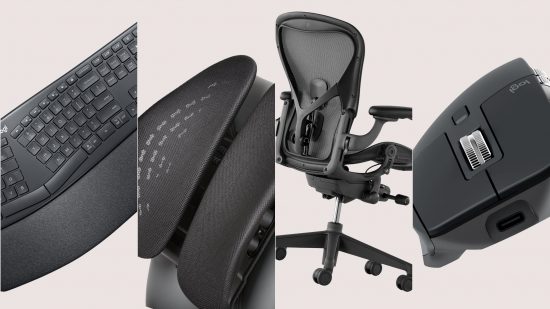Are you looking for ways to make a more comfortable home computer desk space or gaming setup area? If so, this ergonomic gaming guide is the place to be. We’ve spoken to ergonomics experts, tapped into the expertise of colleagues and other home workers, and tested a whole slew of potential desk area upgrades to find the best ways to upgrade and optimize your working or gaming setup space.
Get a proper office chair
It’s such an obvious place to start that it almost feels silly to have to say it, but getting a good office chair really should be your first port of call for making the most of your office space. A good chair will support and cushion your body, raise you to the correct height for optimal comfort, and allow for adjustment to suit your body type.
Not only is it worth spending as much as possible to get these features and improve your comfort, but often cheap chairs just don’t last very long – we’ve used chairs that lose their padding and structural integrity within a year.
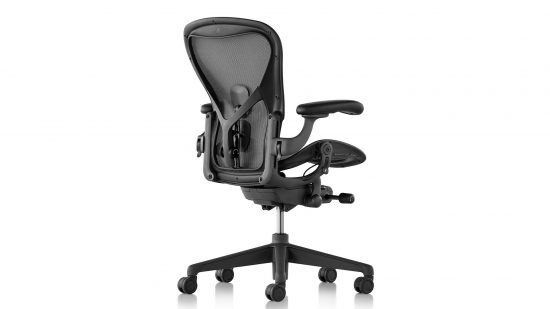
Our tried and tested top choice is the Herman Miller Aeron. The taut mesh seat and back provide excellent support and breathability, keeping you cool and dry. It also has an excellent and easy-to-adjust lumbar support, superb build quality, and a superb recline system that tilts both the seat and the back in unison and does so with effortless ease. Comparatively, some chairs won’t stay tipped back unless you rest your feet on an object to hold them up.
The only problem is that the Herman Miller Aeron price is $1,700 (£1,000) new. You can get them for as little $750 on the second-hand market, but they’re still pricey options.
If the Herman Miller is a little out of your price range, a much more affordable option is the Sihoo M57 ergonomic office chair. It offers a mesh back and seat with adjustable lumbar support, recline, tilt, and even includes a headrest. Build quality isn’t a patch on the Herman Miller, with wobbly parts throughout but it offers decent all-day-sitting comfort for under $200.
A popular alternative to an office chair is to opt for a gaming chair but they can be a bit of a minefield. Build quality tends to be decent in terms of being generally sturdy but they can be hugely compromised when it comes to practicality and comfort. There are three key things to look out for with gaming chairs.
First is to avoid those that have a pronounced bucket racing seat designs. Such seat designs are meant for holding you securely in a car, not providing long-term sitting comfort – the seat and backrest side wings can dig into your hips and push your shoulders forward.
Similarly, many gaming chairs have seats that raise up at the front edge – again a bit like a racing seat – which can dig into the underside of your legs. You want to make sure the front edge of an office or gaming chair gently slopes down, to gradually reduce pressure on your legs.
Thirdly, check the lumbar support of these chairs. Many gaming chairs rely on just a cushion to provide lower back support and the cushions are often awful. They slide around, are either too firm that they poke you in the back or too small that they don’t do anything, and just generally are a waste of time. Instead, you want a properly adjustable, inbuilt lumbar support system to ensure long-term comfort.
Our current favorite gaming chair is the noblechairs Hero. It has a wide, flat seat and back, quality recline mechanism, and in-built lumbar support. It’s not cheap but it’s well built.
Outside of gaming chairs, there are some general tips we can suggest too. Firstly, we really do like a mesh chair. The breathability is a huge help in keeping comfortable for hours on end. Second, make sure the lumbar support is good.
When it comes to the seat, either a good mesh option or one that offers lots of padding is the way to go – skimp on this area and you’ll only end up resorting to cushions later. Like with gaming chairs, ensure the front edge of the chair rolls off gently to reduce pressure un the underside of your legs.
Meanwhile, headrests can be comfy, but for most people they’re a luxury that’s only useful when it comes to reclining, not while sat up working. Likewise, armrests can be useful, but often just as much comfort can be obtained from using wrist rests and otherwise improving the comfort of your peripherals. Non-adjustable headrests are nearly always a waste of time too.
Office chair comfort upgrades
If your budget can’t stretch to buying a new chair or you’re relying on an uncomfy chair at work, there are a few options available to you. For a start, invest in one or several dedicated seat cushions/pads. Don’t rely on scatter cushions salvaged from your sofa, as these seldom offer consistent padding, they slide around, and you end up with little control over the height they provide.
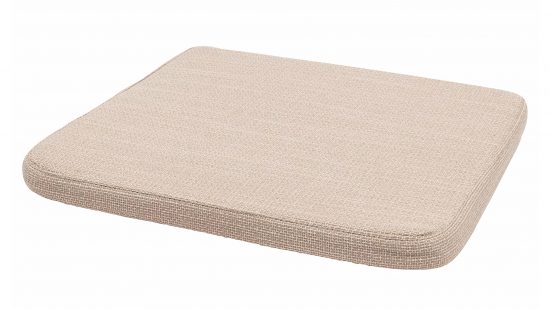
Instead, flat chair pads such as the Ikea Staggstarr (pictured above) or the Milliard memory foam seat pads linked below offer a consistent thickness that means they offer padding right to the edge of the seat. Plus, the flatness and rubber grip on the underside of each cushion means they stack well, making it easy to layer them up to get to the height you need for optimal comfort. What’s more, these same attributes make it relatively easy to tuck one behind your back once you’ve sat down. Normal cushions just slide off.
Another upgrade you can make is an after-market lumbar support, such as the Kensington SmartFit Conform Back Rest ($55), which strap to the back of your chair and provide the extra lower back bump needed to support your back. The support isn’t as firm or smoothly integrated as in quality office chairs, but it’s better than nothing.
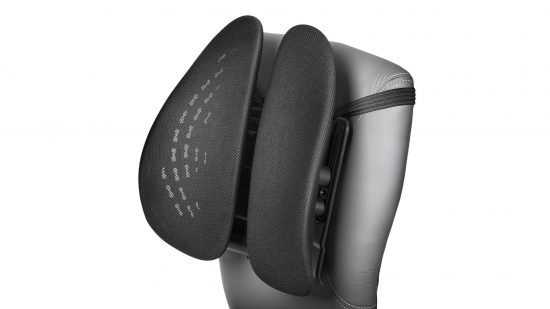
Upgrade your desk
If your current desk consists of little more than a budget table, such as the Ikea Adils/Linmon range, then it’s well worth upgrading to a proper desk, even if you keep the same cheap table legs. Such basic tables tend to be built internally from cardboard (made into a hexagonal, lattice-like honeycomb). so they wobble around, struggle to support heavy objects, and can’t have devices such as monitor arms clamped to them.
Their thickness also increases the likelihood that chair arms or your knees will knock into the edge, which is made all the worse by the surprisingly sharp edges on these cheap tables. At the same time, the area of these tables often isn’t deep enough to accommodate a large monitor with a large stand that takes up half your desk depth.
Handily, you can pick up proper desktop surfaces for around $120 for a 55 x 28 inch (140 x 70cm) desk – 28-inch / 70cm depth is the minimum we’d recommend. These proper desk surfaces are slimmer in profile than most cheap tables, with more rounded corners, and they’re generally deeper, giving you more desk space for all your finest desk clutter. The solid, dense build material can also support greater weight, and be used with desk-clamping monitor arms and other such accessories.
Get a standing desk
All the rage at the moment, standing desks have been hailed as the ultimate way to improve your posture, help burn a few extra calories and generally improve your health, all while still stuck at your desk. Some of these claims are certainly exaggerated – a recent study by the Physical Activity department at the University of Pittsburgh showed that standing only burns eight calories more per hour than the 80 consumed when sitting, compared to 130 more when walking.
However, a change of position is generally considered a positive move compared to prolonged periods of sitting, with it helping to improve circulation and core stability, as well as helping to relieve tension in the neck and shoulders.
Just bear in mind that, as Senior Faculty Editor of Havard Publishing, Robert H. Shmerling, points out, suddenly standing for prolonged periods can introduce just as many problems as it solves, such as lower back, leg, and foot pain. As such, switching to a fixed standing desk isn’t recommended – instead, one of the many adjustable sit-stand desks is the way to go.
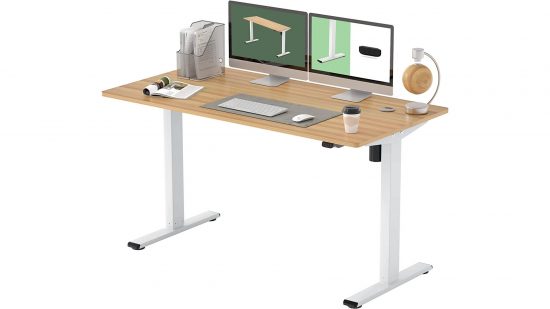
We’ve tested several options, from simple foldout laptop stands that sit on your existing desk, to electrically motorized desks – the whole of which raise and lower at the touch of a button. In general, the electric, full-desk option is the best, as it makes switching between sitting and standing quick and easy, plus you don’t have to worry about rearranging any objects on your desk.
These desks also have a secondary benefit, which is that they allow you to easily set the desk at a comfortable sitting height and not be forced to work around the fixed height of a normal desk – great for taller or shorter-than-average users. What’s more, particularly since the pandemic, the market for these desks has exploded and there are now hundreds of affordable options.
The likes of Flexispot have electric sit-stand desks with 55 x 28 inch tops for just $300, and we can attest to them being decent quality, though spending more can get you better overall build quality, particularly as far as the rigidity of the legs goes. Just a couple of 20-minute standing sessions a day is a great way to keep yourself moving just a little, while not taking you away from work. Just remember to take a break from your screen and go for a walk regularly too.
Get a monitor arm
One of the unexpected consequences of using a standing desk is that, when you stand up, the relationship between your head height and a comfortable arm-resting position changes. In other words, when you stand up, you’ll generally want your monitor to sit higher in relation to your desk than when sat down. Some monitors will have stands with sufficient height adjustment to accommodate a standing desk setup, but many won’t have enough or any at all. That’s where a monitor arm becomes a useful addition.
Fixed to the back of your display in place of its existing stand, and then either clamped to the desk or screwed into a wall, a monitor arm uses the standard VESA screw holes you’ll find on the back of almost all monitors. Some monitors require you to remove some extra parts to access these screws, and there are two versions of the standard – a 75 x 75mm and a 100 x 100mm version – so be sure to check which one your monitor needs.
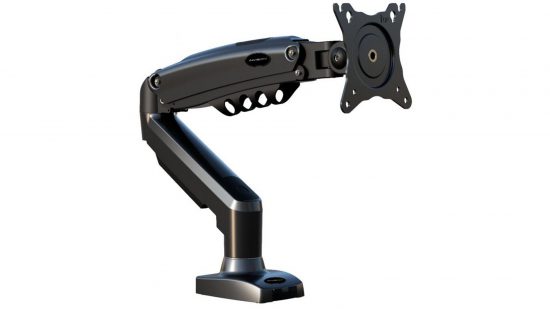
As well as allowing for extra height adjustment, a good monitor arm will enable you to easily pull the monitor back and forth and twist round the display – great for plugging in cables and using the display in a portrait mode. For just $35 or so, you can get an arm that supports 19-32in screens and provides effortless gas piston-assisted height adjustment and an easy install using a desk clamp. If you run two monitors, it’s easy to pick up a twin monitor arm too, for around $60, and these save even more desk space by eliminating two monitor stands.
Get a foot rest or standing mat
The final key piece of the puzzle when it comes to sitting or standing comfortably at your desk is ensuring your feet are correctly positioned in relation to your body. Or, in the case of standing desks, that you’re standing on a comfortable surface.
When it comes to sitting down, many shorter users will find their legs dangle off the front of their chair, even if they’ve lowered their desk as far as they will go. This is not ideal, as it puts extra pressure on the underside of your legs. Even for taller users that don’t have a problem with their feet finding the floor, raising your feet further can make for a more comfortable sitting position, with less desire to cross your legs or fidget. For both these situations, it’s best to invest in a footrest.
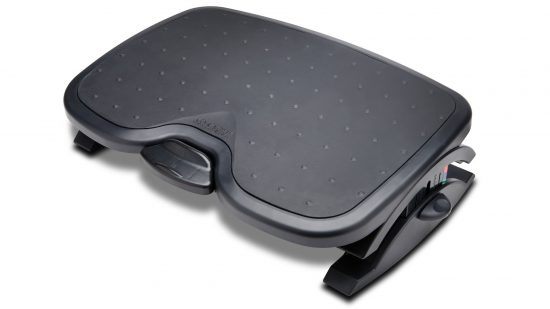
Your two main options are hard plastic rests with adjustable height/angle tops, or you can go for softer solid foam options. We initially preferred the feel of the softer foam foot rest, but ended up choosing the harder rest, as the ability to tip it forward and back allows you to slightly exercise/stretch your feet.
When you’re standing, we can recommend the use of cushioned mats, such as the one above. They’re nothing more than 1.5 inch-thick dense foam mats for slightly cushioning your feet, but they do genuinely work, taking the pressure off your feet and promoting a little extra imbalance that engages your core muscles. However, the big downside with these mats is that once you sit back down, they’re in the way, so you’ll need somewhere on-hand to store them.
Invest in a proper wrist rest
Whatever type of keyboard you own, whether it’s a super high-end custom mechanical keyboard that weighs 3kg, or a lightweight, low-profile Bluetooth option, nearly all conventional keyboards come with rubbish wrist rests. They’re usually insufficiently tall, made from hard plastic, and have sharply-angled corners – they’re seldom even worth taking out the box. Instead, we recommend buying a proper soft wrist rest.
There are umpteen options available, with custom graphics and novelty shapes aplenty. However, for sheer longevity and reliability, you can’t beat the Kensington ErgoSoft ($32). Available in slim, standard and mechanical keyboard variants (and in various colors), which each differ in height to match your choice of keyboard, they offer a wonderfully soft gel top and sturdy rubber base. They also have a smooth uninterrupted surface so they’re easy to keep clean. They also last many, many years – we’ve had a previous version for over ten years.
Ergonomic keyboard benefits
If upgrading your wrist rest doesn’t prove enough of a comfort upgrade for your typing duties, consider swapping to an ergonomic keyboard. These keyboards use a split design where your hands sit on either side of a blank, raised middle section, then incorporate a soft wrist rest that’s raised up above the rest of the keyboard.
The reason for all these changes is that the end product allows your hands to sit at a more natural angle, and not be forced upwards and into a straight line. These keyboard designs have been around for a long time now, and we can attest to their effectiveness.
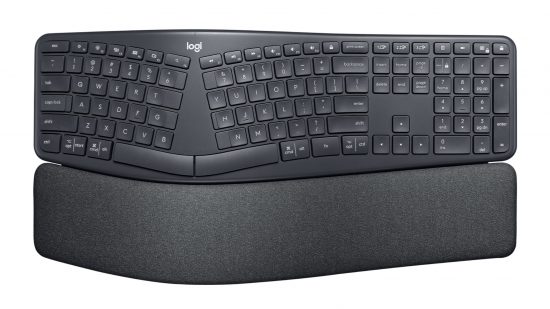
The Microsoft Ergonomic keyboard is the classic option but the Logitech K860 is a particularly good premium option too. It has a great, lightweight, low-profile key action, USB dongle-based wireless and Bluetooth connections, key legends for both Mac and PC and it has buttons for quickly switching between the devices with which it’s paired (up to three at once). It’s also really comfortable to use.
There are two main downsides to these types of keyboards. The first is that there can be a steep learning curve for those not used to disciplined touch-typing. The other factor is that, if you’re a heavy user, these keyboards do wear out quicker than keyboards with mechanical switches.
There are ergonomic mechanical options available, such as the Truly Ergonomic Cleave and Dygma Raise, but they’re very expensive and neither of these options includes a numpad, which rather limits their appeal. In this instance, you basically have to choose between mechanical actuation or typing comfort.
Ergonomic mouse benefits
We’re strong advocates for the latest lightweight, compact models when it comes to gaming mice, because of the performance and accuracy they provide. However, when it comes to longer sessions at your desk, they generally aren’t the most comfortable rodents to use.
It’s well established that excessive or prolonged pronation of the forearm (twisting your hand inwards, as you do when using a normal mouse) leads to a host of painful conditions – ideally our hands should be perpendicular to the desk, not rotated flat onto them. Regular breaks and stretches are all essential tools to alleviate these issues, but what can also help is a more forearm-friendly mouse.
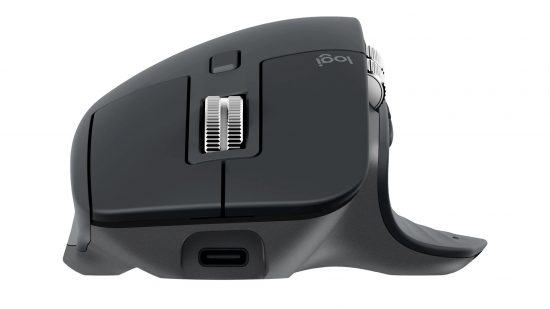
The first stage of slightly improving your wrist position is to opt for a more ergonomic but still conventional mouse. For gaming, the likes of the Glorious Model I, Logitech G703 and Razer DeathAdder offer a bit more hand support and sloped sides to open up your wrist angle more than flatter gaming mice designs – from around 10-15 degrees. However, for gaming mice that’s about as much difference as you can get.
Instead, a great non-gaming option is the Logitech MX Master 3, which sets your wrist at a 25-degree angle. It also features several other ergonomic improvements, including a fully rubberized top that helps to prevent your hand sliding off the mouse. Meanwhile, the clever auto-freewheeling, weighted scroll wheel also makes it effortless to scroll through large documents, while the addition of a sideways scroll wheel for your thumb further reduces the strain on your middle finger having to use the main scroll wheel.
If that’s not enough for you, the next stage is to move up to a proper vertical mouse. The likes of the Logitech Lift and larger Logitech MX Vertical offer a claimed 57-degree wrist angle (about 53 degrees in our measurements), while the Posturite Penguin has a fully vertical, 90-degree design.
The problem we’ve tended to find with these sorts of mice is that they significantly impact your mousing precision, as you have to rely on large wrist movements rather than precise finger movements. We found that the two Logitech ones also require gripping the mouse a bit more firmly than a normal mouse, which introduces its own strains – the Posturite is better in this regard.
The final issue we’ve found with these mice is that the more you twist your forearm back to a neutral/vertical position, the more it exposes the bone of your arm to the edge of your desk. When laid flat, the meat of your forearm muscles act as a cushion, but there isn’t much muscle between the outside edge of your ulna and your skin. The upshot is that using these mice comfortably also means getting a soft wrist rest for your mouse.
Get a decent mousemat
Whatever sort of mouse you buy, getting a quality mousemat is an essential addition to any desk. For a start, while some mice such as the MX Master 3 can work on tricky reflective surfaces, most mice struggle on them, so a proper mouse mat will improve tracking performance and reliability on some surfaces.
What’s more, opting for a soft mousemat will give you a secondary benefit. which is a slightly cushioned desk surface. This goes a surprisingly long way to helping ease any pain from where your wrist rests against the desk, plus it reduces noise and wear on the glidepads/feet of your mouse.
There are countless options available, most of which perform very similarly, but we can attest to the quality and reasonable pricing of Corsair, Glorious, Logitech and SteelSeries mats, which start at around $10 for a 320 x 270mm (12.6 x 10.63 inch) mat. When it comes to size, it’s generally the case that the large the better, so your mouse movements don’t feel cramped and your mouse doesn’t fall off the edge.
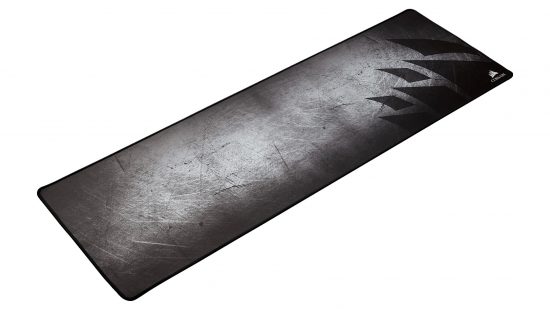
In particular, we’re advocates of the extended mats that go under your keyboard too, as they eliminate the chance of your keyboard and mat getting in the way of each other (a problem on smaller desks if your mat is too large to sit alongside your keyboard). They also provide a secure grip of your keyboard, and the softness can even help your wrists if you don’t have a keyboard wrist rest.
The super-sized mats that cover most of a desk are good too, but in practice they don’t actually provide much meaningful benefit – it’s just handy to have a soft landing zone for your various bits of desk clutter.
Try a trackball mouse
If neither a more ergonomic nor a vertical mouse work for you, then a trackball is a great alternative. The smaller amount of wrist movement, relaxed wrist angle, and use of the more powerful thumb for a lot of movement, means they naturally put far less strain on your body than using a normal mouse. The fact that the unit doesn’t actually move around like a mouse also means they’re well suited to small desk spaces – you can comfortably use one in a gap of only 5in.
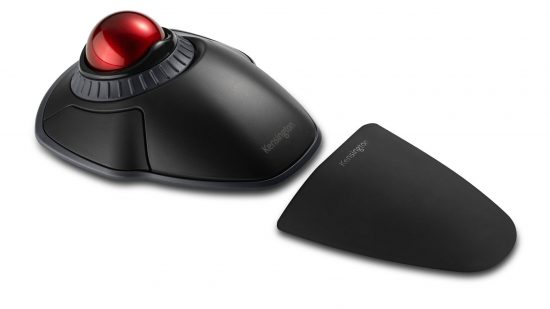
What’s more, it’s surprisingly easy to get used to them. Having never used a trackball before, I tried the wireless Kensington Orbit for this feature and took to it like a duck to water. There are some movements that don’t quite feel as natural as when using a normal mouse – and any first-person gaming is a non-starter – but it was great for standard PC use. The only issue that regularly caught us out was the lack of back/forward buttons, but the Logitech MX Ergo ($110 / £70) offers those features too. For more trackball recommendations, you can check out our guide to the best trackball mouse.
Laptop docks and upgrades
For those of us that either primarily use a laptop or must use one for work, there are a couple of obvious upgrades that we consider essential. The first is a good USB-C hub. Many modern laptops now only include USB-C outputs, which are no good for plugging in most peripherals, so a hub is essential for providing extra inputs and outputs. Moreover, even for those laptops that do have more varied outputs, having a single device that you can leave in place plugged into all your peripherals makes life a lot easier.
There are countless options from which to choose, from small portable units with just a couple of full-size USB ports and an HDMI output, to hefty desk-bound units with masses of connections, mains power input for charging and even KVM switching support – for switching between your laptop and your PC, for instance, at the touch of a button.
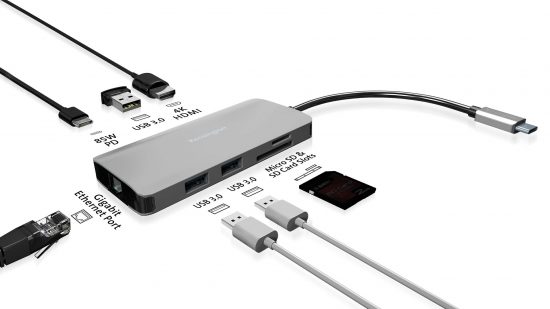
There are countless examples of the smaller style of hubs on Amazon, which we’ve found to be fine, from brands such as Qgeem and Zmuipng. However, availability of specific options and specific brands can be quite unreliable so often it’s difficult to recommend one.
One of the best known-brand examples we’ve used is the Kensington UH1400P. In its impressively small 105 x 52 x 14mm form factor it fits three Type-A USB 3 ports, a USB Type-C port (with pass-through power up to 85W), micro and full-size SD card slots, HDMI 2 and Gigabit Ethernet. The latter port is a particularly rare find on these smaller portable units but still super useful if you’ve networked up your home.
The other big laptop upgrade worth buying is a laptop stand. As well as raising up the screen of your laptop so that it sits at a more comfortable height to view on your desk, a good laptop stand will help your laptop keep cool by opening up access to the bottom ventilation system, and generally improving airflow around the whole chassis.
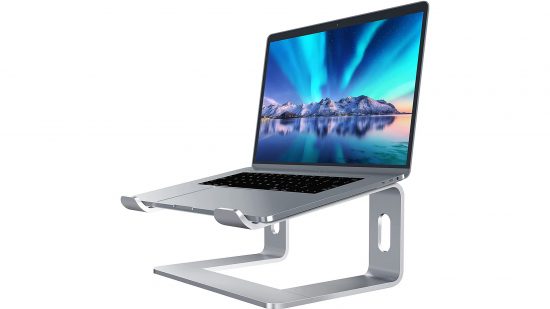
You don’t have to spend megabucks, either. A mere $29 will get you a fixed, solid aluminum stand, such as the Soundance LS1, while just $25 will get you a convenient fold-flat option, such as the Kensington SmartFit Easy Riser Go that’s ideal for travel.
Keep yourself cool or hot
Whether you tend to reach for a hot or cold drink, a universal truth is that it’s all too easy to forget about the drink you just fetched, and by the time you remember it has turned tepid. That’s where the likes of the Yeti Rambler come in handy.
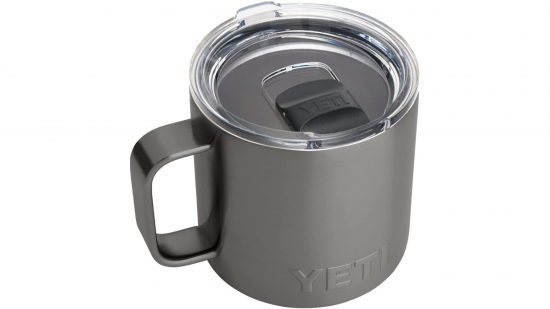
These double-walled stainless steel mugs are amazingly good at keeping drinks at their starting temperature, far more so than many insulated mugs we’ve tried. So much so, in fact, that you’ll need to leave off the lid for a few minutes to let the drink cool down to a vaguely drinkable temperature, before locking in that heat loss with the lid. They’ll work for keeping your chosen cooling beverage cold too. The Ember Smart Mug is a premium but rather brilliant heated mug for keeping your brew at ideal temperature.
If you simply can’t do without your favorite mug, though, another option for hot drinks is a mug warmer. Available in all sorts of random brands on Amazon for around $20, the couple of options we’ve tried make fantastic additions to any desk.
They’re certainly not the most energy-efficient options, and won’t keep your drink piping hot (at least not without a lid for your mug to minimize evaporated heat loss), but they can make all the difference when you’ve been distracted for half an hour and forgotten to finish your brew. No longer will you have to down a stone-cold half mug of tea or coffee.
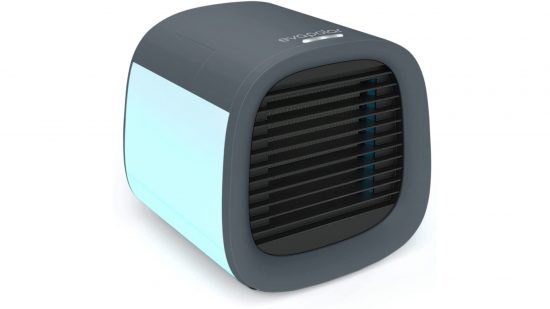
As for keeping yourself cool in these summer months, an obvious room upgrade is an air conditioning unit, but they’re expensive, noisy, and not very efficient. Instead, we can recommend the Evapolar EvaChill evaporative cooler.
This compact, USB-powered unit blows air over a membrane that you dampen with water, and the evaporation of the water helps cool the air as it’s blown past it. They’re nothing new as a concept, but the EvaChill is remarkably compact and relatively quiet. It can sit on your desk pretty much unnoticed and just takes off the edge when temperatures really start to rise.
Add some plants to your desk space
There are few better shortcuts to creating a calming environment than simply seeing some greenery, and while a quick walk in the garden – if you have one – or stroll round the nearest park can work wonders, often it’s not possible to get away from your desk. To this end, one or two plants for your desk, or the shelves next to your desk, are a great way to bring a bit more of a relaxing vibe.
The range of possible indoor plants is vast, but there are a few obvious options that are suited to desk environments. In particular, any sort of succulent such as cacti, aloe, agaves, sansevieria, and sempervivum are ideal, as they’re slow growing and only need occasional watering.

There are many other varieties that are suitable too, but any that require higher humidity – such as ferns, spider plants, orchids and peace lilies – will take a bit more care and attention, as they may need spraying regularly to keep up their ambient moisture level.
While house plants can be lovely, don’t believe the hype when it comes to them oxygenating or cleaning the air in the room. While numerous studies have shown plants can reduce levels of some harmful gases, such as volatile organic compounds (VOCs), the likes of Michael Waring, an environmental engineer and indoor air quality expert at Drexel University, point out that the rate at which they do so is far slower than the rate of air exchange via windows, doors and other gaps in rooms. In other words, you’d need wall-to-wall plants and a very well-sealed room to notice any improvement over the ambient air around you.
What efforts have you made recently to improve the comfort of your home office or gaming setup, and do you have any tips to share? Let us know your thoughts on the Custom PC Facebook page, via Twitter, or join our Custom PC and Gaming Setup Facebook group and tap into the knowledge of our 350,000+ members. Meanwhile, for more PC and gaming setup inspiration, check out our best PC builds guide.
